‘Then There Was War’: John Hejduk’s Silent Witnesses as Nuclear Criticism
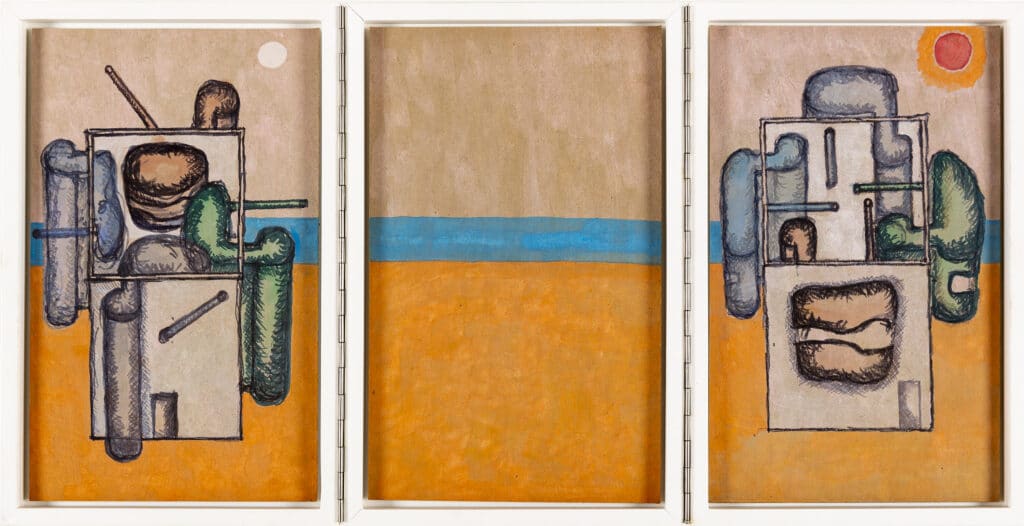
As my title indicates, this text will focus on John Hejduk’s Silent Witnesses project from the mid-1970s, but I want to approach it in the first instance by way of Roland Barthes’s reflections on the ‘Neutral’. This is the topic of the lectures that Barthes delivered at the Collège de France in the Spring of 1978, just two years before his death. The course was organised through a series of considerations of terms that – Barthes observed – came together to form less a dictionary of definitions than what he called ‘scintillations’. [1] For him the Neutral was, he explained, a passionate question and a passionate condition. His interest in it was propelled by a desire for the ‘suspension of orders, laws, summons, arrogances, terrorisms, puttings on notice, the will-to-possess’; in short, the ‘refusal of [a] pure discourse of opposition’. [2] He recalled playing a version of ‘tag’ as a boy, in which those caught were immobilised but could be released when touched by a free child. His greatest pleasure was found, he said, not in catching but in this act of freeing that re-set the game to its point of origin or degree zero or neutral condition – ‘neutral’ because it returned it to a point prior to the establishment of the paradigm of opposition between the catcher and the imprisoned, which is to say the freedom, or better the openness, of the ‘not yet’. In the second lecture one of the ‘scintillations’ that Barthes elaborates concerns ‘silence’, which he suggests in its fully neutral state draws close to mystical visions such as the conception of God put forward by the late-sixteenth/early-seventeenth century German theologian, Jakob Böhme – an a-symbolic ‘calm and voiceless eternity’, homogenous, without oppositions, etc. [3] Yet although he notes at one point that ‘silence is not a sign, properly speaking; it doesn’t refer to a signified’, Barthes quickly goes on to warn: ‘As we know… what is produced against signs, outside of signs, what is expressly produced not to be a sign is very quickly recuperated as a sign. This is what happens to silence… silence itself takes on the form of an image, of a “wise”, heroic, or Sibylline, more or less Stoic posture’. [4]
Now Barthes here gives us a very specific kind of entry into ‘silence’ and I have begun with it because the Neutral is something to which I want to return in due course – but also because he alerts us to the inevitability of the differentiations of what we call silence. And this opens onto the question of the experience, conditions and meanings of particular silences, and the related issues of what counts as silence, for whom, and in what situations – these in turn no doubt being related to what we attend to, what we find meaningful, and our expectations and anticipations. This is simply to say that there are many silences. There are those that mark the passing of some kind of limit condition, such as the limits of representation as associated with the sublime, where the magnitude of that striving to be expressed is beyond symbolisation and so can only be indicated by language’s inadequacy; or those that aim at a heightened or renovated attentiveness, whether that is directed outward or inward or is anticipatory (silences observed as reflectiveness in acts of memorialisation and mourning are of this kind); or those experienced when expectations are confounded or alterities encountered; or those exercised as rights or observed as ethical principles. But then there are also silences that signal the denial of an act of recognition or acknowledgement, or that are produced out of relations of violence and subjection, whether it is the silence that arises from the interdiction of speech or that by which acts of torture authorise themselves.
One of the things that is striking when we list an array of silences like this, is that we usually – and perhaps we have to – silently assume the presence or at least the possibility of a listener, of someone or something that ‘witnesses’ the silence. But this then raises the question of how we might think about the silence that falls with the disappearance of any condition of reception – that is to say, a catastrophic silence, the event of which would eliminate the conditions of possibility for its own recognition and registration. Would it indeed then make any sense to consider this as silence at all? Wouldn’t it rather be the case that silence, as marker of a limit condition, with this loss of witness passes beyond its own limit? It is this that I want to think about and, in doing so, bring into contact with Hejduk’s Silent Witnesses in the hope that it will lead us to a new kind of reading of the work.
A celebrated architect and educator, Hejduk was first Chair and latterly Dean of the school of architecture at the Cooper Union in New York from 1964 until his death in 2000. During the period of his directorship, the Cooper Union developed a reputation as one of the most important international schools of architecture, the other obvious candidate being the Architectural Association in London. Where the AA’s chairman Alvin Boyarsky operated in the mode of an architectural impresario, selecting and appointing tutors who then took up positions within the school’s studio unit system, Hejduk was more like a permanent artist-in-residence whose presence – both through his person and his projects – infused the school, becoming, in a way, materialised in his own renovation of the Cooper Union Building. Where the AA became known for the ‘lateral’ unit system of its diploma school, under which each unit followed a different line of exploration, the Cooper Union became renowned for its cross-year curriculum, which was celebrated in the exhibition (and accompanying book), Education of an Architect: A Point of View, shown at the Museum of Modern Art in New York between November 1971 and January 1972.
Something very evident in Hejduk’s thought, but I think not much remarked upon, is his concern with ambience or atmosphere. Indeed, it seems to me there is a case to be made that ‘atmosphere’ becomes a kind of master-category that is implicit everywhere in the way Hejduk talked about what he did. Not only was his work atmospherically sensitive, born out of atmospheric conditions, but equally the condensation of a particular atmosphere was what the work aimed to achieve. Characteristically, in the dedication of his 1985 collected works, Mask of Medusa, he acknowledged ‘certain places and specific friends’ who ‘created an atmosphere in which my work could move forward in exploration’. [5] And he later went on to explain how the elements in his 1979–83 Berlin Masque were affected by the specific atmospherics of the day on which they were drawn – in the words of his interlocutor Don Wall, ‘overcast days having an analogous affect, humid days affecting the quality of the lead, hence the density of the architecture; and with Chicago, the cold-sickness, heightened sensuality of the body – derelict, impending doom’. [6] This preoccupation with atmosphere carries, it seems to me, implications for how we understand Hejduk’s work and, in particular, its representational conditions. Here he is, for example, speaking of architectural drawing:
What is important is that there is an ambience or an atmosphere that can be extracted in drawing that will give the same sensory aspect as being there, like going into the church and being overwhelmed by the Stations of the Cross (a set of plaques which exude the sense of a profound situation). You can exude a sense of a situation by drawing, by model or by good form. [7]
What strikes me here is the way this view tends to dissolve any sense of modes of architectural representation as being secondary to what they depict, as thought atmospherically the drawing or model does the same thing as the building. Likewise architecture is now the ‘same’, in this sense, as painting. Like the young Roland Barthes releasing his immobilised friends, the sensibility of atmosphere allows Hejduk to neutralise categorical distinctions that isolate and partition things, which now enter a free relationship with one another. We see this very directly in his identification of the uncanny atmosphere of Le Corbusier’s Maison La Roche with Ingres’s portrait of the Comtesse d’Haussonville. Here is Hejduk again, from one of the interviews with Wall:
Remember our discussion of the Madame d’Haussonville and the widow’s walk? I discussed then, the whole ambience, the whole mood, the whole sensibility that was captured by Madame d’Haussonville and by the Villa La Roche. There was something in there that I thought was authentic; there was a mood, a tone… [8]
Notably, both of these are represented in the compendium of images without words that Hejduk published in 1982 under the title ‘Silent Witnesses’, which, it appears to me, was aiming to work as a kind of Warburg-like mnemosyne atlas of atmosphere instead of gesture. [9] (See fig.2)
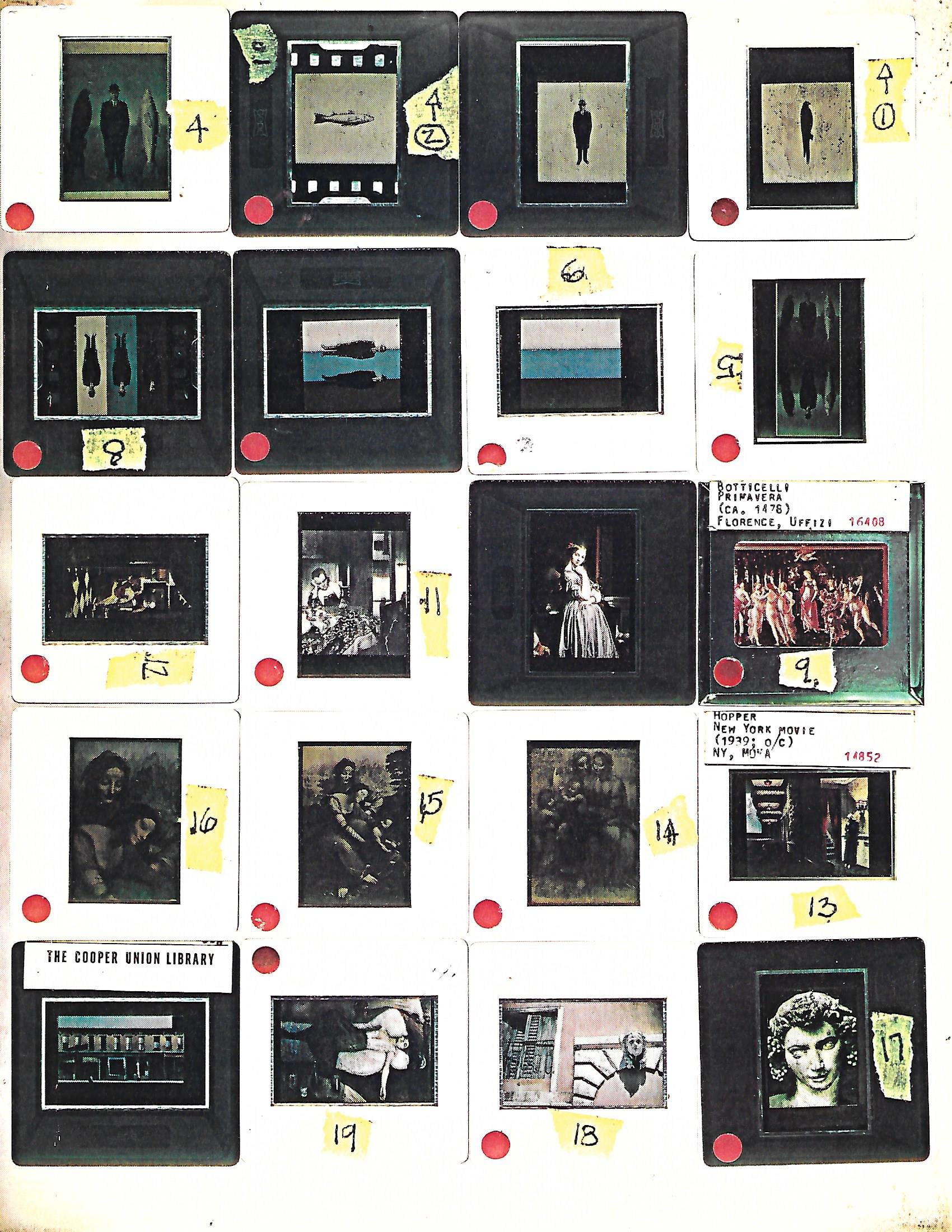
Let’s turn at this point to look in detail at the Silent Witnesses project in the various manifestations that it takes. It is a distinctive and unusual work when viewed within Hejduk’s production. Often viewed as transitional, in Mask of Medusa it is spoken of as one of a trilogy of projects – which include the Cemetery for the Ashes of Thought and the Thirteen Watchtowers of Cannaregio [10] – that come between the preceding house projects and the subsequent ‘Masques’. Certainly, when compared to, say, the Wall Houses or the Masques, it seems to have received very little attention and commentary, yet if it is a marginal project it is at the same time one that clearly held a certain kind of centrality for Hejduk. ‘To me’, he declared, ‘the Silent Witnesses is my most important statement’. [11] The period of its development was one of a new intensity of engagement with Europe for Hejduk, one refracted through his own self-narration as an architect caught between Europe and America. (I think there is an argument that for Hejduk the American condition itself was about being caught between Europe and America). Crucial to this was his meeting with the Italian architect Aldo Rossi and the example of his work, in which Hejduk discerned a combination of ‘sensuousness’ and ‘dread’. [12] During these years his work moved, he would comment, towards an ‘Architecture of Pessimism’. [13]
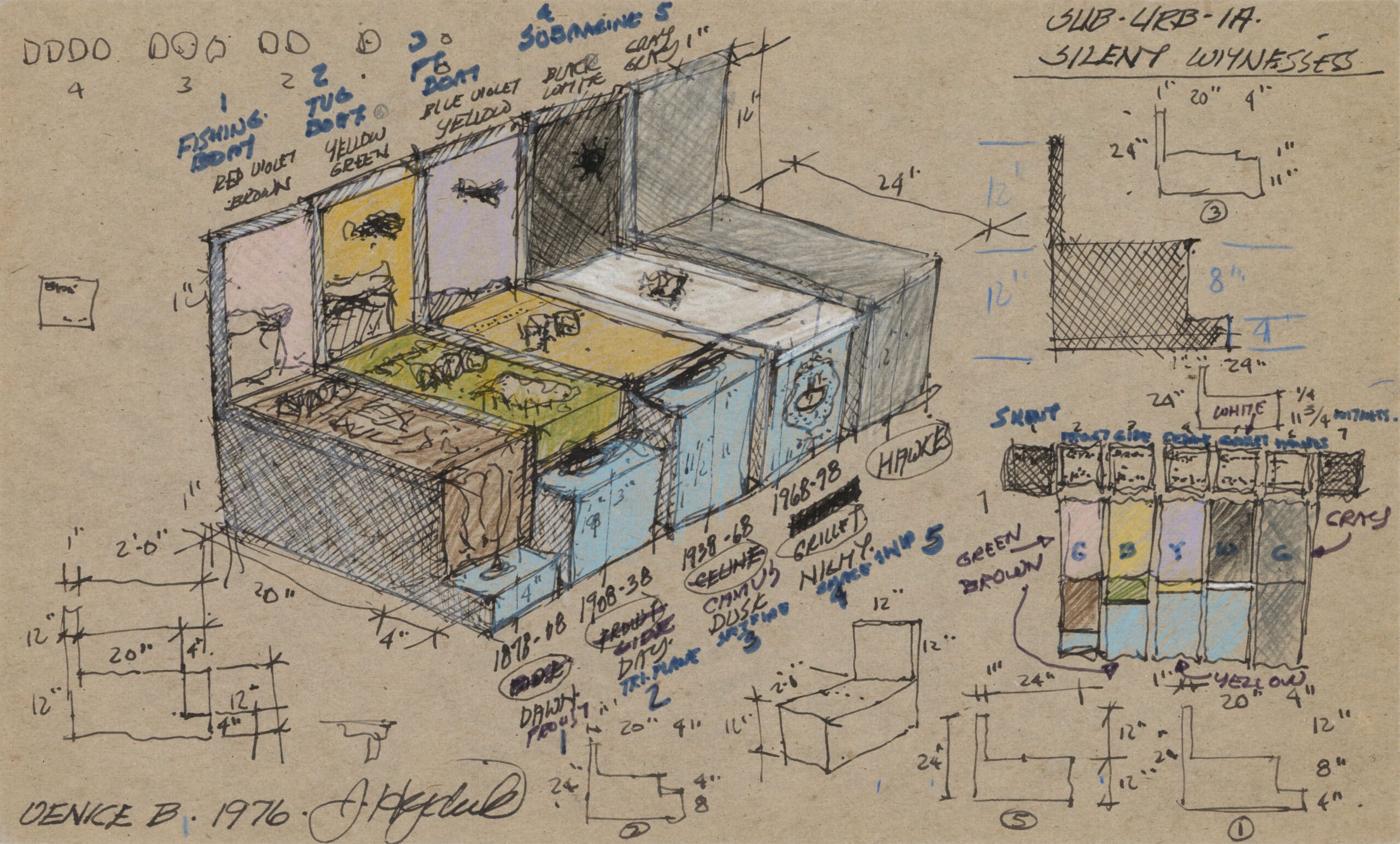
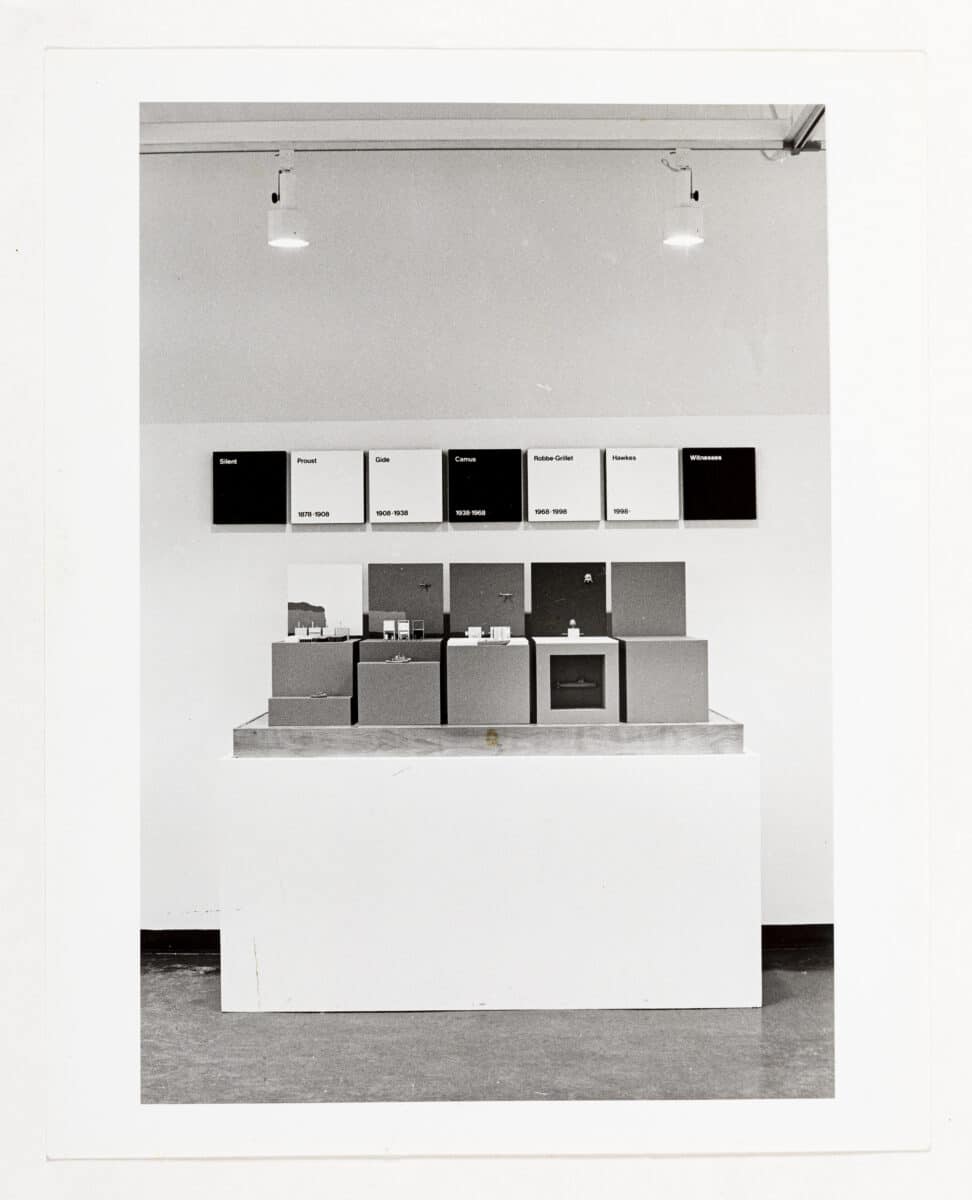
The Silent Witnesses installation takes the form of five plinth-like constructions (Fig.3 and 4) – maybe we would call them models, as Hejduk himself sometimes did – that sit alongside one another, each below a corresponding plaque on which appears an author’s name, together with a date range: Proust 1878–1908; Gide 1908–1938; Camus 1938–1968; Robbe-Grillet 1968–1998; Hawkes 1998–. [14] Through these five constructions runs a common datum line upon which one or more architectural elements are located, save for the last, which is empty. When seen from above we realise that, as the sequence develops, these elements step incrementally toward the viewer. (Fig.5) Another level or rather a series of levels are established by grey-blue volumes at the front of the constructions upon which, in the first three, float three different kinds of boats. On the fourth, the boat has sunk below the surface to become a submarine. The fifth, again, is blank. Each of the constructions, moreover, has a panel at the rear. The first three are painted with parts of what looks like a possibly continuous landscape that seems to disappear on the fourth, although Hejduk’s drawings confirm the continuity. (Fig.6) The middle panels have objects in flight standing out in half-relief – a bi-plane, a Spitfire fighter, and what appears to be an Apollo landing capsule, and hence something descending, although Hejduk spoke of it as a ‘spacecraft going out to infinity’. [15] The fifth is once more mute, silent, and empty. With its uncompromising frontality (the work was exhibited against a wall) and its combination of three-dimensional models and painted backdrop, the Silent Witnesses recalls the form of the diorama – perhaps one like the natural-historical dioramas and habitat groups that were pioneered at the American Museum of Natural History, which Hejduk recalled visiting in the 1930s as a child. [16] ‘I was drawn’, he wrote, ‘to the exhibits where animals natural to Africa were shown in three-dimensional panoramas. The scenes were remarkable, for in a very contained and compressed space, great distances in perspective were depicted. I remember always searching for the demarcation line, that is, where the actual three-dimensional object left off and the illusionistic perspective began. I never found that line.’
Returning after many years, he found to his dismay that these magical windows of his childhood had been replaced with new installations and that the line for which he had vainly searched in the past was now clearly visible. ‘[The] old realists had passed on’, Hejduk comments. ‘So I picked up a one-inch deep cardboard box, made a crude wood frame around it, and put within the box a small house and a cross section of a tower. I painted these with watercolours’. [17]
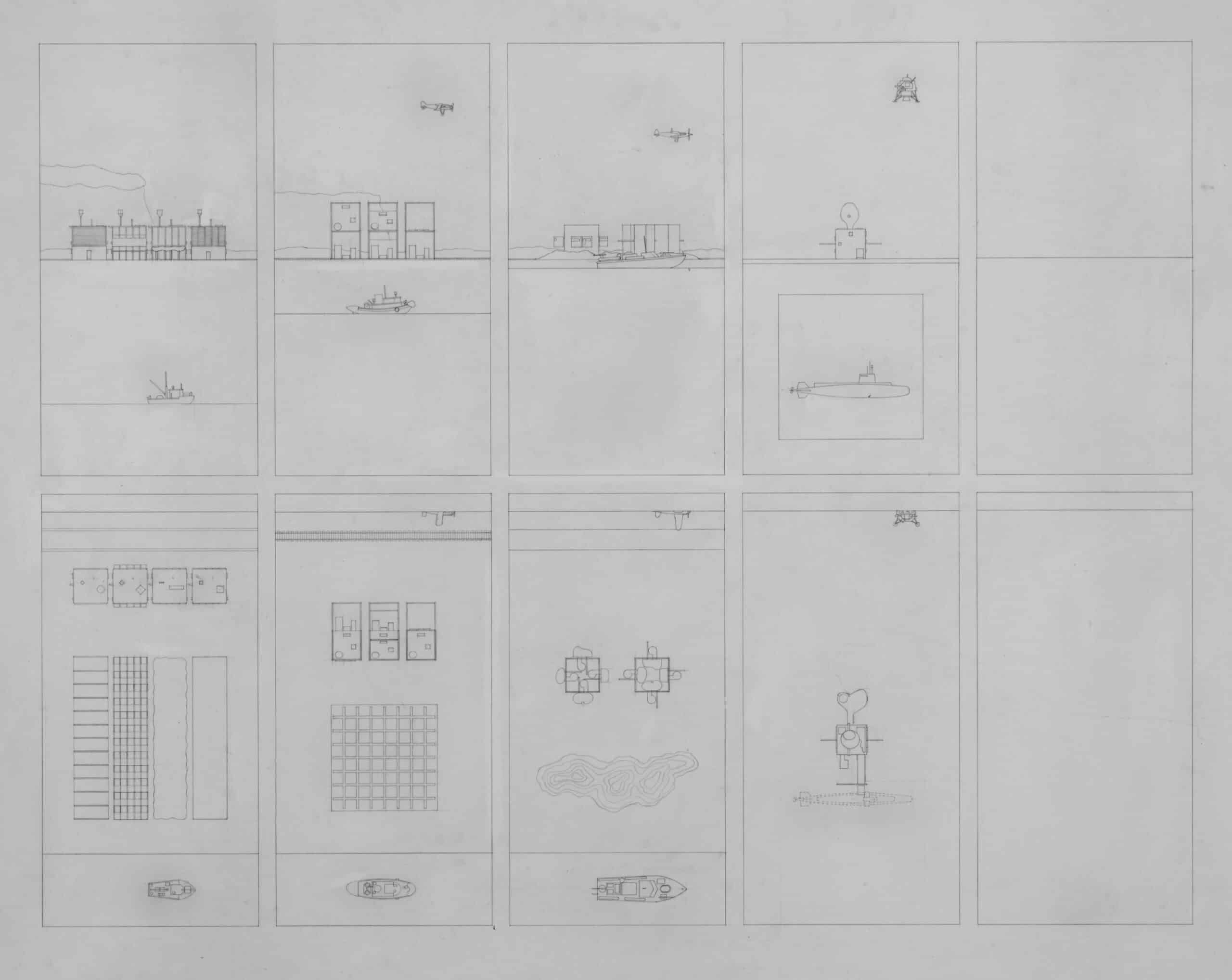

I wonder how we might think about what’s going on in this allegory-like story, within which world history and personal experience seem so intertwined? Certainly it is a generational lament for the passing of the ‘old realists’, but at the same time it is a lament for the loss of enchantment and illusion – and maybe also of childhood. It is a story of a historical dividing line that turns on a story of a dividing line – Hejduk’s demarcation line – whose emergence into visibility registers a shift in conditions of representation that must be acknowledged and that cannot be reversed or reset. It is surely important here that this is also a generational lament issued across the historical fracture of the war and more particularly the abyss opened up by the development and use of atomic weapons and the unending foreshadowing of the future that that presaged. If ‘our time’, as Hejduk would write, ‘has been deeply influenced by schizoid/frenetic forces let loose after World War II’, then this inevitably finds an inscription in the Silent Witnesses, which he in fact would characterise as ‘a physical panoramic landscape of 120 years of history’, a description that makes it sound very much like a transposition into time of the spatial dioramas of his childhood. [18]
This returns us to our title, ‘Then There Was War’. The phrase is drawn from Hejduk’s telling of another early experience, that of playing with toy soldiers. Here he talks of how:
I spent eons of hours and days with those British lead soldiers. They don’t make them anymore. But they were made in the 30s… At that miniature scale one develops a tactile sense. And of course there was the organisation… one constantly organised them in lines of marching soldiers, in all sorts of geometric battle patterns. Then there was war. Everything would disperse in chaos. A lot of them would drop dead. Then you would put them all back up, but maybe this time in a different pattern. [19]
Now, it seems to me that something rather like this is being played out across the toy-like tableaux of the Silent Witnesses, although with a significant difference. Key to Hejduk’s self-understanding was the sense of belonging to a specific generation – a late generation, a third one, coming two after the modern masters of architecture, Le Corbusier, Mies, and Wright. Hejduk articulated this lateness in a militarised way. It was almost as if the third generation found themselves in the aftermath upon the field of battle. ‘The original new ground had already been decisively broken’, he writes. ‘What remained was a job of filling in… to “fill in”. We had witnessed the result of a bombardment.’ [20]
Silent Witnesses is a project about generations. Hejduk says this explicitly via a reference to Ortega y Gasset, and it structures the thirty-year intervals that give the five boxes their temporal rhythm – or at least four of them, for the fifth is again both inside and outside the series. And it is a project that begins – and, it seems to me, ends – with war. Of its development Hejduk writes, ‘I started with 1938, the year war began in Europe, and I worked my way backwards and forwards’. [21] (Presumably 1938 because it was the year of the Nazi annexation of Sudetenland from Czechoslovakia – Hejduk himself was of Czech descent). Thus we have the 1938–68 span described as ‘war time’; the 1968–98 range, ‘ice time’; and the 1998– forward, if it is forward, ‘grey matter’. [22] In some ways Hejduk’s date plaques, under whose sign the models are placed, are redolent of certain art practices of the period, such as the date paintings of the New York-based Japanese artist On Kawara, which he produced from 4 January 1966 until his death in 2014. In a recent essay, Susan Stewart has linked these – following testimony by Kawara himself – to the detonation of the atomic bombs at Hiroshima and Nagasaki. Here the compulsive re-registration of the day signaled a continuing if provisional presence against the backdrop of a technology that, as Stewart writes, is ‘world-destroying, and hence time-destroying’. [23] To his associates, Kawara sent occasional telegrams that announced ‘I am still alive’, and rendered his age in days lived (29,771, by the time of his death). [24] In Kawara’s work, the repetitive inscription of ascending dates seems like a kind of counting up – and at first sight Silent Witnesses looks like this too, with its rising dates and datum, the sea level freezing in the fourth box which holds that most emblematic of Cold War vessels, the nuclear submarine. But at second glance, we recognise that this is shadowed by a more pervasive sense of counting down, marked by the number of the houses on the tableaux– four, three, two, one – until we arrive at the grey box, at which point counting ends. And now the horizontal dash that follows 1998 seems less an indicator of unending futurity than of the collapse of time, its horizontality perhaps reiterated in the celebrated construction of that name realised outside the Architectural Association in London’s Bedford Square in October 1986.
In what way did Hejduk describe the five constructions from the Silent Witnesses? ‘The models’, he wrote, ‘remind me somehow of being medieval and they tell a story, even if only a literal one’. They can also, he continued, be seen as ‘caskets’, and specifically ‘the caskets of children’. [25] This seems obscure, although our earlier remarks suggest that the sequence might be read as a series of toys. For its part, the term ‘medieval’ carries a particular value in Hejduk’s discourse insofar as it stands for the pre-modern and against the rationality of the modern period. It is very clear that Hejduk understood his architecture of ‘pessimism’ as a kind of return of the ‘medieval’. Hejduk’s use of the word ‘casket’ remains odd however, not least because only the fourth model, the one that harbours the submarine, has any directly legible condition of interiority. But the fact that the caskets form a series and that they are chromatically – or, better, tonally – differentiated is suggestive, not least because it recalls the story of the three caskets found in the late-thirteenth/early-fourteenth century compilation of tales, the Gesta Romanorum. This story formed the template for the act in Shakespeare’s Merchant of Venice in which the suitors compete for the hand of Portia through a choice of caskets, these being respectively made of gold, silver, and grey lead. And of course it is the last of these, the one whose outward appearance makes it seem least valuable, which turns out to be the correct choice. Now, the way in which this is developed in an inverted form in Freud’s 1913 essay ‘The Theme of the Three Caskets’ is interesting for us. Although there is not space to explore it in detail here, it is important that we note the movement of Freud’s argument. He identifies the choice between three caskets with that of the choice between three women – specifically that made by the elderly King Lear between his daughters. Lear of course makes the wrong choice, one that forsakes the undemonstrative and silent Cordelia. Freud writes: ‘Cordelia makes herself unrecognisable, inconspicuous like lead, she remains dumb, she “loves and is silent”… We may perhaps be allowed to equate concealment and dumbness… Gold and silver are “loud”; lead is “dumb”’. [26] However, for Freud, the development of the theme, whereby the third choice is the ‘correct’ – enlivening, vivifying – one, is the result of a consoling ‘reaction formation’, in which something has been substituted by its opposite. And it is the underlying deathliness, he suggests, that the leaden silence of the third continues to point to, a meaning that he relates to the third figure in mythic female triads (the Fates, the Norns, etc.).
Certainly, in the Silent Witnesses the final casket is – as in the tale – grey, leaden and silent. As Hejduk says: ‘And then there’s the last one. There’s nothing. Just the grey all the way through – the density of butter. All the pictures, all the artifacts, all the elements have disappeared. There’s nothing left but the grey, solid casket.’ [27] Let’s think at this point about what grey is for Hejduk. His earlier work is, it seems to me, characterised by a very particular attention to colour, in which the primaries of De Stijl met with a self-conscious use of the kind of naive colour associations familiar from toys. Listen, for example, to this exchange from the interviews with Don Wall:
Wall: How do you make specific decisions as to the choice of colour, shape arrangements… That Wall House over there – why the blue, the green and so forth?
Hejduk: [Laughs] The reasoning is that blue is simply for bath, the red was for warmth, for fireplace, the yellow was for kitchen, the grey was for library, the black was for sleeping… it all was banal reasoning, you see, really banal… [Keeps laughing]. [28]
But on Hejduk’s encounter with the Maison La Roche in 1972, his approach to colour altered:
After visiting La Roche my sense of colour changed. The colours there were muted and saturated at the same time, and they changed constantly. I saw how primary colours could be greyed down, and yet made more saturated, more dense. So the Bye House is a colour wheel of muted primaries, and muted complements, with a grey wall. The wall is like a filter – a neutraliser. The grey of the wall is in all of the other colours, which are thereby neutralised… muted, yet more intense. [29]
What seems to be happening here is that Hejduk’s work is moving toward – at least conceptually – a condition of grisaille, a kind of tonal painting in neutrals that is often associated with the representation of sculpture. But note too how this is referred back to the grey of the wall – to the wall as greyness – for it is specifically this that starts to emanate through the project. Greyness is for Hejduk a spatial condition, that of the wall as a non-identical third term with respect to the exterior/interior opposition, but as such it is also the temporal idea of the instantaneity of the present – ‘a membrane between two worlds so to speak’, Hejduk says. ‘That’s why the facade is a plane, thin and coloured grey.’ [30] Hejduk’s reading of Jay Fellows’s book on Ruskin, The Failing Distance, seems to have been key to the way he formulated these relations. Perspective, he explained, is a diamond configuration flattened out with the point in the distance. So that at the moment of madness, the diamond configuration turns in upon the person internally.
Well, that moment is the hypotenuse, which is the point of entry-exit, the threshold. The hypotenuse of the diamond perspective is what I call the moment of the present which I suspect might also be considered the moment of death… [The] hypotenuse of the perspective is constantly in motion and flattening as you approach any building from the exterior. It flattens out right on top of you at the moment of entry – the moment of the present. It is the quickest condition time-wise; also, it’s at once the most extended, the most heightened, and at the same time the most neutral and repulsive. [31]
It’s very hard not to read this and connect it with the Lacanian diagram of the optical construction of the Subject. In Lacan, however, the Subject’s loss of self-possession is linked to the presence of the gaze of the Other in the visual field, which is directed back toward it. For Hejduk the concern is, in a sense, the same – the death of the subject, the ‘moment of death’ as he writes. But now this occurs by, in effect, having the Subject walk into the screen – and hence, I suppose, the grey blindedness, which Hejduk seems to have equated with a pure condition of opacity: ‘There’s nothing. Just the grey all the way through – the density of butter’. [32] At one point in the interviews published in Mask of Medusa, Hejduk says that if any of his late works would be built…
Hejduk: …I would move to another level of detailing. I would go to lead. I would go to…
Wall: Why lead? Does lead suggest a particular content? I know that many of the recent writings refer to metallics.
Hejduk: Non-reflective metals. Pewter.
Wall: Inert? Deadly in associative value?
Hejduk: No. Thick. Weight. Weight. It’s the weight [long pause]. That’s an interesting question. Let me think… [33]
When Hejduk says of the last grey, deathly, leaden, casket in the Silent Witnesses that ‘All the pictures, all the artefacts, all the elements have disappeared’ I think we have to understand him as gesturing to a notion of total nuclear war as catastrophe without remainder, as apocalypse without revelation and, as such, as something that can only be proleptically mourned in advance, for no symbolic possibility – no pictures, artefacts, elements – outlasts it. Here perhaps is the final meaning of the casket as ark, archive, and archival destruction. This is a concern that animated Jacques Derrida’s important essay on nuclear criticism, in which he pointed out the necessarily fabulous nature of such a conception – that is, of total, remainderless war – which can by definition have no referent. This is not to say that it cannot be actualised and made real, only that its condition in the living present is always inevitably one of being a story. He writes: ‘One has to distinguish between this “reality” of the nuclear age and the fiction of war. But, and this would perhaps be the imperative of nuclear criticism, one must also be careful to interpret critically this critical or diacritical distinction. For the “reality” of the nuclear age and the fable of nuclear war are perhaps distinct, but they are not two separate things. It is the war (in other words the fable) that triggers this fabulous war effort, this senseless capitalisation of sophisticated weaponry, this speed race in search of speed’. [34] But of course this entails that the only resource to press against this, to push against what could be, is also inevitably the fable. And here we find that the Silent Witnesses, which perhaps seemed eccentric before, becomes reincorporated with the allegorical core of Hejduk’s work.
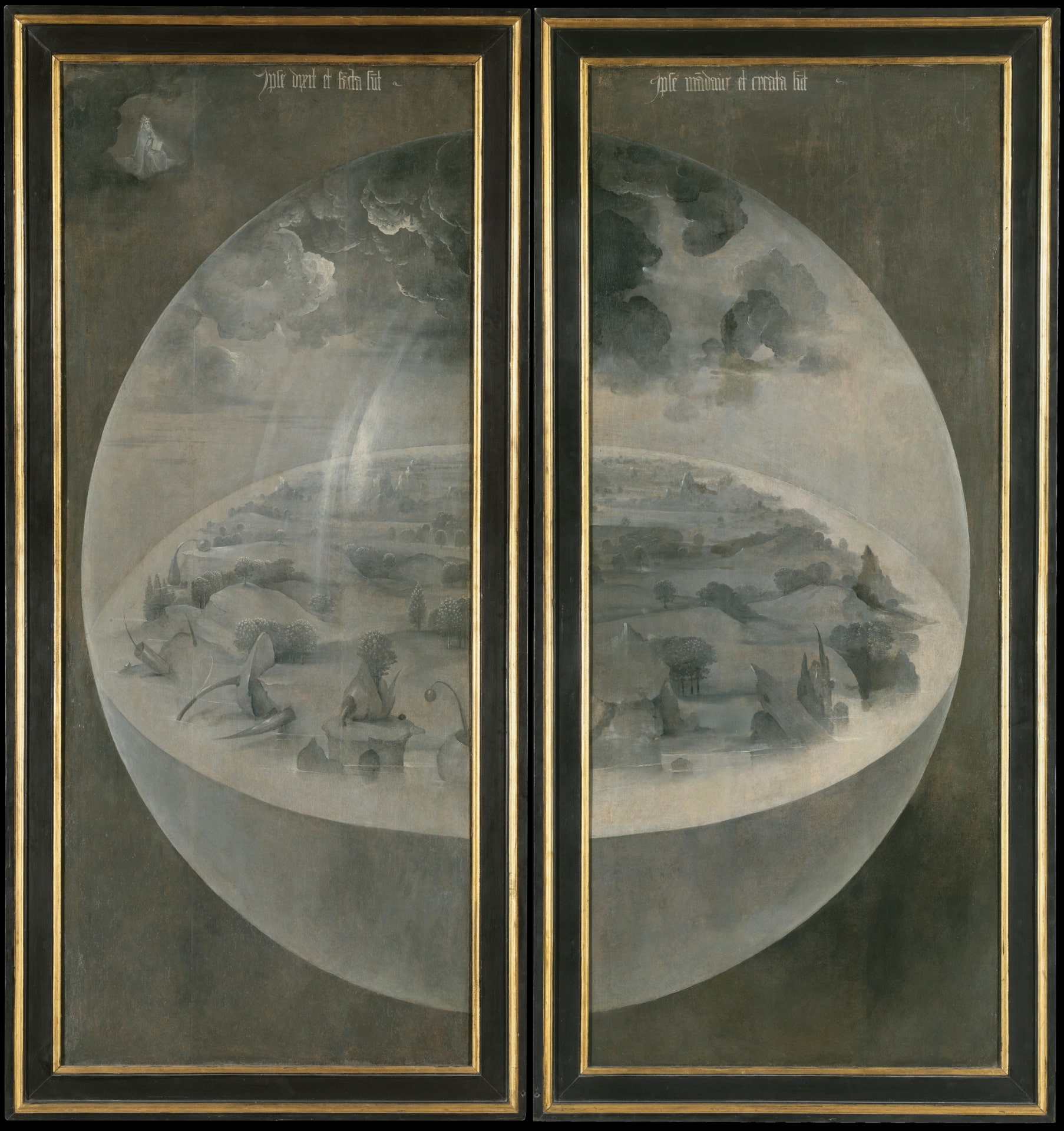
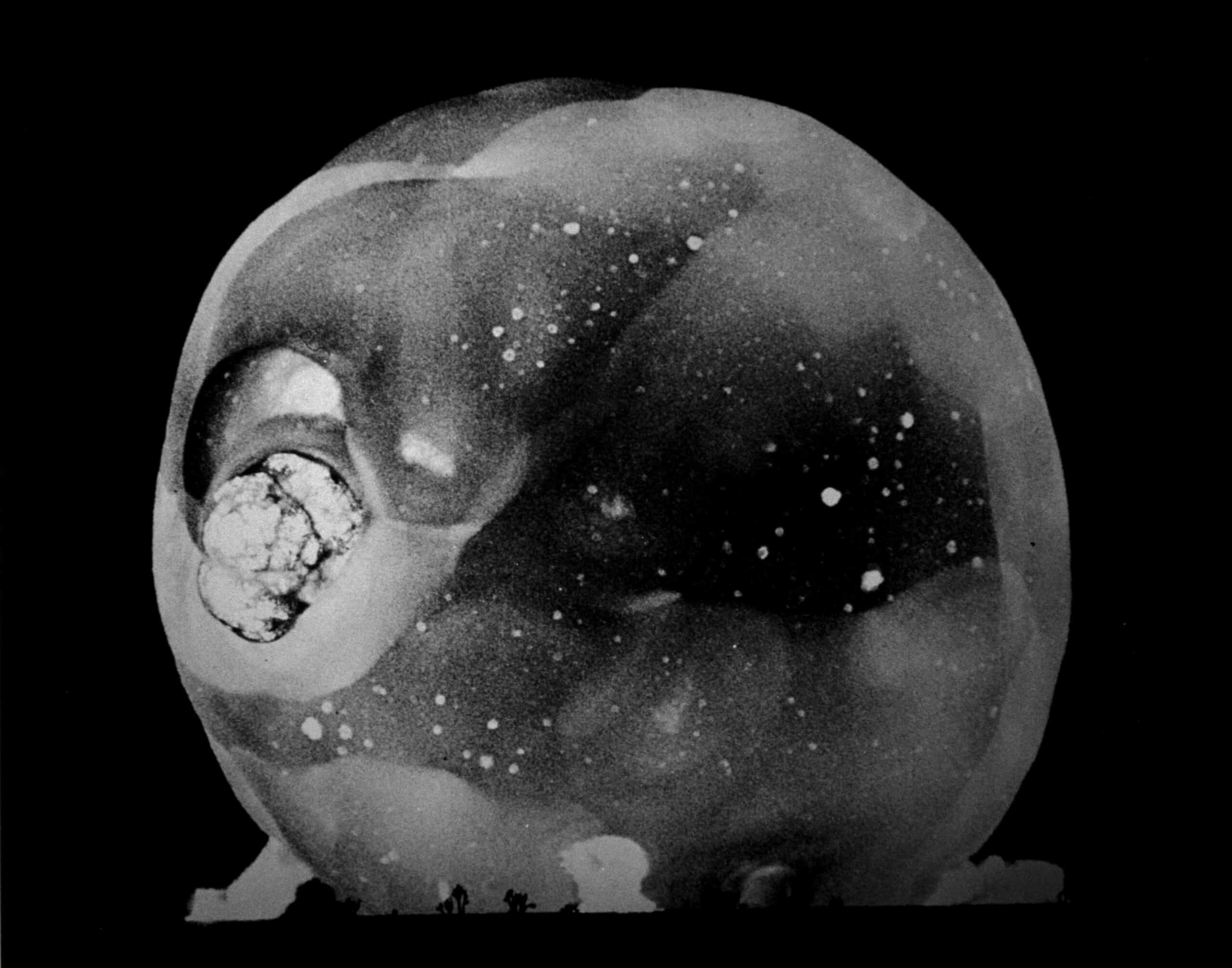
Let’s conclude with two images, which I suppose are – in their different ways – images concerning both the neutral and silence. The first will take us back to Roland Barthes, who has something interesting to tell us about grisaille (of which we spoke earlier). He develops this in a beautiful way in relation to the painting on the exterior panels of Hieronymus Bosch’s triptych The Garden of Earthly Delights. Where colour oppositions are, as Barthes argues, the very model of the paradigm, ‘the opposition par excellence’ (blue=water vs red=fire, etc.), the monochrome (the Neutral) substitutes for the idea of opposition that of slight difference, of the onset, of the effort toward difference, in other words, of nuance: nuance becomes a principle of allover organisation (which covers the totality of the surface, as in the landscape of the triptych) that in a way skips the paradigm: this integrally and almost exhaustively nuanced space is the shimmer… the Neutral is the shimmer. [35]
The second image is one of Harold Edgerton’s ultra high-speed photographs of the atom bomb tests in Nevada taken for the US Atomic Energy Commission circa 1952.
While the first is an image of an awakening world, shimmering with immanent liveliness on the edge of differentiation, the second is of a movement in the other direction. And I feel it is the latter that the Silent Witnesses, in its own way and on its own terms, addresses. The Silent Witnesses turn out to be witnesses of silence, but it is a silence to which we are no longer sure that we can attach the name.
Extracted, with permission, from The Place of Silence: Architecture / Media / Philosophy by Mark Dorrian and Christos Kakalis (2020), published by Bloomsbury Visual Arts, an imprint of Bloomsbury Publishing Plc. Available here.
Notes
- Roland Barthes, The Neutral: Lecture Course at the Collège de France (1977-78) (New York: Columbia University Press, 2005), p.10.
- Ibid., p.12.
- Ibid., p.22.
- Ibid., p.24, 26.
- John Hejduk, Mask of Medusa: Works 1947–1983 (New York: Rizzoli, 1985), p.5.
- Ibid., p.125.
- Ibid., p.58.
- Ibid., p.129.
- John Hejduk, ‘Silent Witnesses’, Perspecta 19 (1982): p.70–80.
- See Daniel Libeskind’s 1978 introduction in Hejduk, Mask of Medusa, pp.15–22; pp.21–22.
- Hejduk, Mask of Medusa, p.81.
- Ibid., p.91.
- Ibid., p.83.
- Photographs of the installation are shown on pages 333 and 337 of Mask of Medusa. An image of it also appears on the website of The Renaissance Society, University of Chicago. Accessed 25 April 2018.
- Hejduk, Mask of Medusa, p.81.
- On the American Museum of Natural History dioramas, see Donna Haraway, ‘Teddy Bear Patriarchy: Taxidermy in the Garden of Eden, New York City, 1908-1936’, in Primate Visions: Gender, Race and Nature in the World of Modern Science (Verso: London and New York, 1992): pp.26–59.
- Hejduk, Mask of Medusa, p.96.
- Ibid., p.23, 81.
- Ibid., p.61.
- Ibid., p.26.
- Ibid., p.81.
- Ibid. Hejduk designates 1878–1908 ‘pastoral time’ and 1908–1938 ‘mechanical time’.
- Susan Stewart, ‘Annal and Existence: On Kawara’s Date Inscriptions’, in Jeffrey Weiss, with Anne Wheeler, On Kawara – Silence (New York: The Solomon R. Guggenheim Foundation, 2015), pp.171–177; p.171.
- Roberta Smith, ‘On Kawara, Artist Who Found Elegance in Every Day, Dies at 81’, The New York Times, July 15 (2014). Accessed 20 June 2016.
- Hejduk, Mask of Medusa, p.81.
- Sigmund Freud, ‘The Theme of the Three Caskets’, in Art and Literature: The Pelican Freud Library, Volume 14 (Harmondsworth: Penguin, 1988), pp.235–247; pp.238–239.
- Hejduk, Mask of Medusa, p.81.
- Ibid., p.53.
- Ibid., p.76.
- Ibid., p.62.
- Ibid., pp.62–63.
- Ibid., p.81.
- Ibid., p.124.
- Jacques Derrida, ‘No Apocalypse, Not Now (Full Speed Ahead, Seven Missiles, Seven Missives)’, Diacritics 14, no.2 (Summer, 1984): pp.20–31; p.23.
- Barthes, The Neutral, p.51
